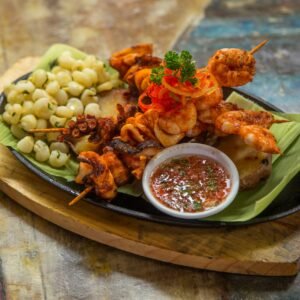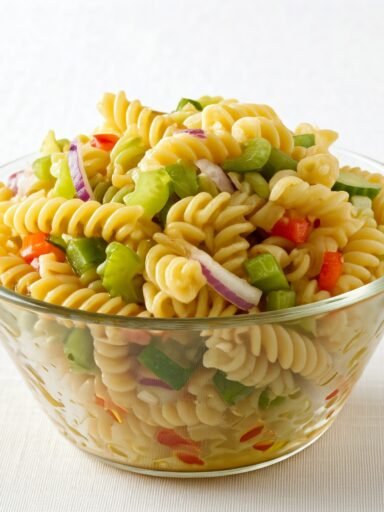
Shrimp Étouffée Recipe
Ingredients
- 1 pound large shrimp peeled and deveined
- 1 tablespoon vegetable oil
- 1/2 cup all-purpose flour
- 1 onion chopped
- 1 green bell pepper chopped
- 2 celery stalks chopped
- 2 cloves garlic minced
- 1 bay leaf
- 1 teaspoon Cajun seasoning
- 1/2 teaspoon paprika
- 1/4 teaspoon cayenne pepper
- 2 cups chicken broth
- 1 cup tomato sauce
- 1 tablespoon Worcestershire sauce
- Salt and pepper to taste
- Cooked white rice for serving
Instructions
- Make the Roux: Heat the vegetable oil in a large Dutch oven over medium heat. Gradually whisk in the flour until smooth and golden brown. This process, called making a roux, is crucial for thickening the sauce.
- Sauté the Vegetables: Add the onion, bell pepper, and celery to the roux. Cook until softened, about 5-7 minutes. Stir in the garlic, bay leaf, Cajun seasoning, paprika, and cayenne pepper. Cook for another minute.
- Add the Liquids: Pour in the chicken broth, tomato sauce, and Worcestershire sauce. Bring to a simmer, then reduce heat to low.
- Cook the Shrimp: Add the shrimp to the sauce and cook until pink and cooked through, about 2-3 minutes.
- Season and Serve: Season with salt and pepper to taste. Remove the bay leaf. Serve over cooked white rice.
- Tips:
- For a spicier étouffée, add more cayenne pepper or a dash of hot sauce.
- You can also add other seafood to this dish, such as crab or crawfish.
- Serve with a side of crusty bread to soak up the delicious sauce.
- Enjoy your homemade shrimp étouffée!
Introduction to Shrimp Étouffée
Shrimp Étouffée is a beloved dish that encapsulates the rich culinary heritage of Louisiana, a region renowned for its vibrant Cajun and Creole cuisines. This flavorful stew is characterized by its use of shellfish, particularly shrimp, which is cooked down in a thick, savory sauce that often includes the classic “holy trinity” of Cajun cooking: onion, bell pepper, and celery. Étouffée, a French term meaning “smothered,” refers to the method of cooking where the ingredients are covered and allowed to simmer, allowing the flavors to meld into a comforting dish that delights the senses.
The origins of shrimp étouffée can be traced back to the diverse cultural influences that have shaped Louisiana cuisine, from French settlers to African and Spanish elements. As a staple in both Cajun and Creole kitchens, it holds a special place in the hearts and traditions of many Louisianans. Sharon, a native of New Orleans, fondly recalls how shrimp étouffée became a cornerstone of her family gatherings. Each year, during Mardi Gras or holiday celebrations, the kitchen would fill with the tantalizing aroma of simmering shrimp étouffée, a dish that symbolized togetherness and joy.
Growing up, Sharon often watched her grandmother expertly prepare this classic meal, sharing stories and laughter amidst the clanging of pots and pans. It was during these gatherings that Sharon learned not only to appreciate the unique flavors of shrimp étouffée but also the significance of food as a means to bring family together. As the foundation of many cherished memories, shrimp étouffée embodies the essence of nurturing through cooking, making it more than just a delectable dish; it is a celebration of family and culture that continues to thrive in Sharon’s home today.
The Rich History of Étouffée
Étouffée, a dish synonymous with the culinary heritage of Louisiana, holds a rich history that reflects the diverse cultural influences of the region. The term “étouffée” translates from French to mean “smothered,” indicative of the cooking technique employed in preparing this delicious stew. Its origins can be traced back to the early French settlers who brought their culinary traditions to America in the 18th century. By intertwining their methods with local ingredients and cooking styles, they laid the foundation for what would eventually become a beloved Louisiana staple.
As the culinary landscape of Louisiana evolved, so did étouffée. The dish began to incorporate influences from various cultures, including African, Spanish, and Native American. This amalgamation of flavors is evident in classic recipes that often feature shellfish, particularly shrimp or crawfish, along with the “Holy Trinity” of Cajun cooking: onions, bell peppers, and celery. The dish is distinguished by its seasoning, which may vary but typically includes garlic, cayenne, and other spices that highlight the depth of flavor characteristic of Louisiana cooking.
Traditionally, étouffée was reserved for special occasions or family gatherings, symbolizing the warmth and generosity often associated with Southern cuisine. As time progressed, the dish became more accessible, finding its way onto restaurant menus across Louisiana and beyond. For those interested in a deeper exploration of étouffée’s history, resources such as the “New Orleans Cookbook” by Rima and Andrew B. deVere provide insights into its evolution and significance within American haute cuisine.
With its layered flavors and historical significance, étouffée serves as a testament to the blending of cultures and traditions in Louisiana. It is not simply a dish; it is a representation of a rich culinary heritage that continues to evolve while celebrating the influences that shaped it.
Meet Sharon: The Cook Behind the Recipe
Sharon is a devoted mother of two adult children, who have significantly shaped her culinary journey. Known for her warmth and hospitality, Sharon has always embraced the role of both a nurturing figure and an accomplished cook. Her passion for cooking began in her childhood, where she often watched her mother skillfully prepare traditional family meals. This early exposure instilled in her a deep appreciation for home-cooked dishes, which she has since passed on to her children.
Over the years, Sharon’s kitchen has become a hub for family gatherings, where cherished memories are created over shared meals. Her children, each with unique tastes and preferences, have influenced her cooking style immensely. Knowing that food is a universal language that brings people together, Sharon has made it her mission to accommodate various palates while preserving the essence of her cherished recipes. The love and care she puts into each dish reflect her understanding of the emotional connection that comes with food, making her culinary creations resonate deeply with those who enjoy them.
As a proud cook, one of Sharon’s standout dishes is her Shrimp Étouffée, a recipe that embodies both her flair for cooking and the significance of family traditions. This dish, rich and flavorful, has become a household favorite and is a testament to her ability to infuse love into every bite. Sharon’s enthusiasm for sharing this particular recipe reflects her desire to keep the family spirit alive and connect with others through shared culinary experiences. As she continues to evolve her skills, her goal remains simple: to bring joy to her family and friends through delicious, heartfelt meals.
Exploring the Aroma and Flavor Profile
Shrimp Étouffée is a dish that embodies the rich culinary heritage of Louisiana, presenting a bouquet of delightful aromas and flavors that instantly evoke memories of home-cooked meals. At the heart of this dish lies a carefully curated blend of ingredients, each contributing to its distinctive character. The foundation of Shrimp Étouffée consists of the holy trinity of Cajun cooking: onions, bell peppers, and celery. This combination not only provides a robust base but also releases a mouth-watering fragrance as it sautés, inviting everyone to gather around the table.
The addition of garlic enhances the overall aroma, infusing the dish with an unmistakable warmth. However, it is the generous use of spices, including cayenne pepper, paprika, and thyme, that truly sets Shrimp Étouffée apart. These spices create a harmonious balance between heat and flavor, offering a tantalizing experience that warms the soul. The star of the dish, the shrimp, plays a pivotal role, adding a sweet and succulent taste that melds beautifully with the spicy roux, which serves as the sauce’s thickening agent. The roux itself, made from flour and oil, is cooked to a rich brown color, imparting a nutty flavor that enhances the dish’s depth.
As residents of coastal regions are well aware, the ocean’s bounty is best experienced in its freshest form. Fresh shrimp complements the base flavors while also bringing a distinctive brininess that transports the diner to the shores of Louisiana’s Gulf Coast. The resulting complexity of flavors creates a comforting atmosphere during meals, as each bite reminds families of the love and care poured into preparing this cherished dish. By evoking fond memories and creating lasting culinary traditions, Shrimp Étouffée has truly earned its place as a family favorite across generations.
Ingredients: What You’ll Need
To create Sharon’s beloved shrimp étouffée, you will need the following ingredients, measured precisely for optimal flavor and texture. This dish is traditionally rich and hearty, thanks in part to its well-chosen components.
First, you will need 1 pound of large shrimp, preferably raw and peeled to maintain the freshness that is essential for authentic étouffée. In terms of vegetables, include 1 cup of chopped onions, 1 cup of chopped green bell peppers, and 1 cup of chopped celery, often referred to as the “Holy Trinity” in Cajun cuisine. Additionally, you’ll require 2 cloves of minced garlic to add depth to the flavor.
For the base of the étouffée, you will need 1/4 cup of vegetable oil and 1/4 cup of all-purpose flour, which will be used to create a roux—a crucial element that gives this dish its characteristic richness. To enhance the flavor profile, add 3 cups of chicken broth, along with 1 tablespoon of Worcestershire sauce and 1 teaspoon of hot sauce. Seasoning is key; therefore, salt and black pepper to taste are necessary.
Fresh herbs elevate this dish further; you will need 2 tablespoons of chopped fresh parsley and 2 green onions, chopped. While these add a burst of freshness, they can also be substituted with dried herbs if fresh varieties are unavailable. For those having difficulty finding certain ingredients, local markets often stock Cajun essentials, and organic stores may offer appropriate substitutes.
Having all these ingredients gathered ensures you are ready to embark on the culinary journey of making Sharon’s shrimp étouffée. The combination of these components contributes to a flavorful, comforting dish that many families cherish.
Step-by-Step Cooking Instructions
Preparing Sharon’s Shrimp Étouffée involves a series of straightforward steps that ensure a flavorful and satisfying dish. To begin, gather all necessary ingredients: shrimp, butter, onions, bell peppers, celery, garlic, tomato paste, chicken broth, Cajun seasoning, and green onions for garnishing. This preparation will streamline your cooking process.
Step 1: Start by making a roux. In a large skillet, melt ½ cup of butter over medium heat. Once melted, gradually whisk in ½ cup of flour. Cook this mixture, stirring constantly, until it transforms into a rich brown color, which may take about 10-15 minutes. It is crucial to maintain a consistent stirring motion to prevent burning and to achieve the desired flavor profile.
Step 2: After achieving the roux, add 1 chopped onion, 1 chopped bell pepper, and 1 cup of chopped celery to the skillet. Sauté these vegetables until they are softened, which typically takes around 5 minutes. This step enhances the dish’s overall flavor by incorporating the aromatic properties of the vegetables into the roux.
Step 3: Next, incorporate 3 cloves of minced garlic and 2 tablespoons of tomato paste. Cook for an additional 2-3 minutes, stirring frequently. The garlic should become fragrant but not browned, contributing depth to the étouffée.
Step 4: Gradually add in 4 cups of chicken broth while continuously stirring to prevent lumps from forming. After the broth is fully incorporated, mix in 2 tablespoons of Cajun seasoning. Allow this mixture to simmer for about 10 minutes, letting flavors meld together beautifully.
Step 5: Now, gently fold in 1 pound of peeled and deveined shrimp. Cook for approximately 5-7 minutes or until the shrimp are pink and fully cooked. Be cautious not to overcook the shrimp, as this can result in a rubbery texture.
Step 6: Finally, serve your shrimp étouffée over a bed of rice and sprinkle with chopped green onions for added freshness. Enjoy this hearty dish that is sure to become a family favorite, perfect for gatherings or a cozy dinner. With each step carefully executed, the shrimp étouffée promises a rewarding culinary experience.
The Benefits of Homemade Étouffée
Preparing Shrimp Étouffée at home offers numerous advantages over purchasing it from restaurants. One of the primary benefits is the freshness of ingredients. When making this classic Louisiana dish in your own kitchen, you can select high-quality seafood and produce, ensuring that every component is at its peak flavor and nutritional value. Fresh shrimp, aromatic spices, and vibrant vegetables can significantly enhance the final dish, creating a more enjoyable dining experience.
Another major advantage is the ability to customize the recipe to suit individual tastes and dietary preferences. While restaurants may offer a standard recipe, homemade Étouffée can be easily tailored to accommodate different palates. For example, those who prefer a milder flavor can adjust the level of spice, while individuals with specific dietary restrictions can substitute ingredients. Whether it’s swapping out shrimp for a vegan alternative or omitting certain vegetables, the flexibility of preparing Étouffée at home allows for a personalized dining experience for friends and family.
Furthermore, there is a unique satisfaction that comes from cooking for loved ones. The act of preparing Shrimp Étouffée can be a bonding experience, allowing family members to come together in the kitchen. Involving others in the cooking process can foster teamwork, making the meal even more special. The aroma emanating from the kitchen as the dish simmers serves as an invitation for enjoyment, creating anticipation for the meal that follows. Additionally, serving a homemade dish can evoke a sense of pride and accomplishment, knowing that your efforts contributed to bringing loved ones together around the table.
Incorporating homemade meals into family traditions can create lasting memories, reinforcing the connection between cooking and togetherness. Overall, the benefits of making Shrimp Étouffée at home greatly enhance the overall meal experience.
Tips for Perfecting Your Étouffée
Creating a truly memorable shrimp étouffée involves attention to detail and careful execution of cooking techniques. One of the foundational steps is preparing the roux, which is essential for achieving that rich, flavorful base. A darker roux, which requires careful stirring over low heat for a longer duration, can impart a deep, nutty essence to the dish. Patience is crucial here; avoid rushing the process as a well-prepared roux is the hallmark of a great étouffée.
When choosing ingredients, freshness is paramount. Select the best quality shrimp available and, if possible, opt for shell-on shrimp for added depth of flavor. The shells can be simmered with the broth to deepen the flavor profile. Additionally, incorporating aromatics such as onions, celery, and bell peppers in the “Holy Trinity” of Cajun and Creole cooking will provide a robust foundation for your dish. Sauté these vegetables until they are soft and fragrant, ensuring you release their natural sweetness.
For enhancing the flavor, consider adding a blend of spices that resonate with the dish’s regional characteristics. Common additions such as cayenne pepper, thyme, or bay leaves can elevate the aromatics. A splash of Worcestershire sauce or a hint of hot sauce can introduce a pleasant kick, while ensuring the balance of flavors remains intact. Lastly, allow your étouffée to simmer gently for a sufficient time. This not only melds the flavors beautifully but also allows the shrimp to absorb the seasoning without overcooking.
Serving the étouffée over a bed of rice can give each bite balance and texture, making it a complete and satisfying meal. Consider garnishing with fresh parsley or green onions to add a touch of color and freshness. These small steps contribute significantly to perfecting shrimp étouffée and will impress those who gather around the dinner table.
Serving Suggestions for Shrimp Étouffée
Shrimp étouffée is not only a delightful dish in its own right, but it also provides an opportunity to elevate your dining experience with creative serving suggestions. This flavorful Cajun classic can be complemented by various side dishes that enhance its rich taste and texture. A staple pairing is fluffy white rice; its neutral flavor absorbs the zesty gravy beautifully, providing a satisfying base for the shrimp. For a more adventurous option, consider serving shrimp étouffée over savory grits or creamy polenta, which add depth and a delightful creaminess to the meal.
To cater to a well-rounded meal, consider incorporating fresh, sautéed vegetables. Presenting a medley of asparagus, green beans, or roasted bell peppers alongside the étouffée not only adds vibrant color to the plate but also introduces a fresh crunch that balances the dish’s richness. A crisp salad with a vinaigrette dressing can further enhance the meal by cutting through the indulgence of the shrimp étouffée, making for a harmonious dinner ensemble.
When it comes to wine pairings, a light, refreshing white wine generally complements shrimp étouffée exceptionally well. Opt for a chilled Sauvignon Blanc or a dry Riesling; both wines enhance the dish’s flavors without overpowering them. If you prefer red wine, a light Pinot Noir can also work but should be chosen carefully to keep the meal balanced.
For a beautiful presentation, serve the shrimp étouffée in shallow bowls, allowing the shrimp and gravy to take center stage. A sprinkle of fresh herbs, such as parsley or green onions, on top can add a nice touch of color and freshness. With these serving suggestions, your shrimp étouffée will become a memorable highlight at any dining occasion.
Traditional vs. Modern Variations
Shrimp étouffée is a dish deeply rooted in Creole and Cajun culinary traditions, with its origins tracing back to Louisiana. Traditionally, this iconic dish is prepared with a rich, flavorful roux, which is a combination of oil and flour cooked until it reaches a deep, dark brown color. Along with this, the dish typically incorporates the “holy trinity” of vegetables: bell peppers, onions, and celery, along with fresh shrimp, spices, and herbs. Each family often has its own recipe that has been passed down through generations, preserving the regional authenticity and traditional flavors.
However, as culinary practices have evolved, modern variations of shrimp étouffée have emerged, showcasing creativity and adaptability. Contemporary cooks often experiment with ingredients based on personal preferences, dietary restrictions, or the availability of local produce. For instance, some may choose to use a lighter base, opting for a white roux or even gravies made from vegetable or chicken stock rather than the traditional oil and flour mixture. This adaptation caters to those striving for healthier meal options without compromising taste.
Additions such as different types of seafood, like crab or scallops, and even vegetarian adaptations with mushrooms or tofu provide fresh takes on this classic dish. Furthermore, some culinary enthusiasts may incorporate international spices or ingredients, such as incorporating coconut milk or chilies, to create a fusion of flavors that appeal to diverse palates. Despite these modern adaptations, the fundamental essence of shrimp étouffée remains, as it continues to evoke a sense of comfort and nostalgia for many, ensuring its status as a beloved dish in both traditional and contemporary cuisines.
Cooking for Large Gatherings
When preparing Sharon’s Shrimp Étouffée for a large gathering, it is essential to scale the recipe while maintaining the integrity and flavor that makes this dish a family favorite. This rich and flavorful shrimp dish can serve as the centerpiece for any event, and with careful planning, it can be adapted to accommodate a crowd.
Start by calculating the number of servings needed. Typically, a standard serving of Shrimp Étouffée is around one cup, which allows for generous portions alongside rice or bread. If you’re expecting 50 guests, for instance, you should aim to prepare approximately 50 cups of the étouffée. Given the nature of gatherings, it is wise to prepare a little extra to ensure all guests are satisfied.
Next, gather your ingredients. When scaling the recipe, it is advisable to increase the quantities of your main ingredients proportionally. For example, the shrimp, vegetables, and roux can simply be multiplied by the necessary factor to ensure a consistent flavor profile. However, when cooking in larger quantities, attention must be paid to the cooking times and techniques. It is often more effective to prepare the dish in batches. This approach preserves the complexity of flavors and prevents overcrowding in the pot, which can result in uneven cooking.
Moreover, when preparing for large groups, consider delegating some tasks. Assigning someone to handle rice or bread allows you to focus on perfecting the étouffée. For serving, buffet-style meals work well, making it easy for guests to help themselves and enjoy your shrimp étouffée at their leisure. Lastly, always allow time for the dish to simmer once cooked, as this step enhances the flavors even further and creates a beautifully cohesive dish that everyone will love.
Storing Leftovers: Best Practices
When it comes to storing leftovers of Sharon’s shrimp étouffée, proper techniques are crucial to preserve both quality and flavor. After your meal, it is advisable to allow the shrimp étouffée to cool down at room temperature for no more than two hours. This step is important in preventing bacterial growth, which can occur at higher temperatures. Once the dish has cooled, transfer it into airtight containers for optimal storage.
Using glass or BPA-free plastic containers is highly recommended for storing shrimp étouffée. Glass containers have the advantage of being microwave-safe and do not retain odors or stains from food, enhancing their longevity. If you choose plastic containers, ensure they are labeled as microwave-safe and free from harmful chemicals. Additionally, smaller containers can help with portion control and make reheating easier.
In terms of duration, properly stored shrimp étouffée can last in the refrigerator for about three to four days. If you would like to extend its shelf life further, consider freezing the dish, which can keep it safe for about two to three months. When freezing, it’s advisable to label the containers with the date to keep track of their freshness.
When reheating shrimp étouffée, to maintain its rich flavor and texture, opt for low and slow methods. Using a stovetop over medium heat can best preserve the dish’s integrity. Stir occasionally to ensure even heating and prevent the shrimp from becoming overcooked. Alternatively, a microwave can be used, but it is essential to cover the container to retain moisture. Adding a splash of broth or water can also help rejuvenate the dish’s flavors during reheating.
Fun Facts About Shrimp Étouffée
Shrimp étouffée, a dish synonymous with the rich culinary traditions of Louisiana, belongs to a class of Creole and Cajun cuisines that highlight fresh seafood and aromatic spices. The term “étouffée” translates to “smothered” in French, aptly describing the process of cooking this dish. Traditionally, shrimp étouffée is prepared by smothering shrimp in a thick, flavorful sauce made from a roux, vegetables, and a blend of spices. This method not only enhances the taste but also exemplifies the technique of cooking that has been passed down through generations in Southern households.
One fascinating aspect of shrimp étouffée is its regional significance. Often served over rice, it reflects the cultural mosaic of Louisiana, where both Creole and Cajun influences converge. While shrimp is the most common protein used in this dish, variations abound. Some might use crayfish or a combination of seafood, showcasing the availability of fresh ingredients in coastal regions. This adaptability makes shrimp étouffée a versatile favorite, accommodating different tastes and preferences across families and restaurants.
Moreover, shrimp étouffée has made its mark in media and pop culture. The dish features prominently in various culinary television shows, food challenges, and cookbooks, highlighting the growing interest in authentic regional cuisines. Additionally, many Louisiana festivals celebrate this dish, where local chefs compete for the title of the best shrimp étouffée, further connecting the dish to the community and its cultural heritage. As such, shrimp étouffée stands not only as a delicious meal but as a symbol of Louisiana’s rich food history, embodying traditions, creativity, and communal spirit.
Making It a Family Affair
Cooking can be an enriching experience, particularly when it involves the entire family. Sharon’s Shrimp Étouffée, a cherished family recipe, serves as an excellent opportunity for family bonding through culinary activities. The preparation of this flavorful dish allows every family member to participate, fostering teamwork and communication.
One way to engage the family in the cooking process is by assigning specific tasks based on age and skill level. For instance, younger children can assist in washing the vegetables or measuring out the spices, while older children can take on responsibilities like chopping ingredients or stirring the pots. This division of labor not only makes cooking more efficient but also empowers children with valuable cooking skills.
Moreover, families can take turns choosing the music playlist while preparing the Shrimp Étouffée. This not only sets a joyful tone but also creates an enjoyable atmosphere that can lead to laughter and shared memories. If the family has a preferred style of music, it can enhance the cooking experience and make it more personal and fun.
Additionally, setting aside time to discuss the origins or significance of the Shrimp Étouffée recipe can deepen family connections. Sharing stories of family gatherings centered around this dish fosters appreciation and connection to heritage. Such discussions often spark curiosity in younger generations about cooking traditions, motivating them to learn more.
After the Shrimp Étouffée is prepared, families can enjoy a meal together, further solidifying the experience. Combining cooking and dining together not only strengthens family ties but also cultivates a love for home-cooked meals. Engaging in the kitchen as a family is an experience filled with learning, laughter, and togetherness, creating cherished memories that can be passed down through generations.
External Resources and References
For readers interested in delving deeper into the rich culinary traditions surrounding Shrimp Étouffée, several external resources provide invaluable insights. One of the most comprehensive sites dedicated to Cajun and Creole cooking is Cajun Cooking Recipes, where you can find a plethora of authentic recipes, stories, and cooking techniques that highlight the cultural significance of dishes like Étouffée.
Additionally, the NPR article titled “The Mayonnaise Commander: Custodian of Creole Cooking” offers an engaging look at the culinary heritage of Louisiana and the chefs who preserve it, including insights into dishes such as Shrimp Étouffée. This resource underscores how Étouffée can showcase the blend of cultural influences in Southern cuisine.
For those seeking a more interactive experience, the Food Network’s collection of shrimp recipes includes a section dedicated to Étouffée preparations. It not only introduces an array of variations but also highlights shrimp’s versatility and importance in various dishes, reinforcing its status as an essential ingredient in numerous culinary traditions.
Lastly, culinary lovers can benefit from the informative articles hosted on the Saveur magazine website. This publication often covers the cultural context of dishes like Shrimp Étouffée, offering insights into its origins and evolution, and providing tips for perfecting the dish at home. Exploring these references will enrich the reader’s understanding and appreciation of Shrimp Étouffée, solidifying its place in both family traditions and the broader culinary landscape.
Reader Testimonials and Experiences
At the heart of every cherished recipe lies countless memories, often shared around the dinner table with loved ones. Sharon’s Shrimp Étouffée has become not only a family favorite but also a standout dish for many who have had the opportunity to savor it. We invite you to share your experiences and stories in the comments section below, as we believe the best recipes are enriched by the personal anecdotes of those who prepare and enjoy them.
Many diners have recounted their heartfelt experiences with Sharon’s Shrimp Étouffée. For instance, Sarah M. shared how the dish evoked nostalgia from her childhood, reminding her of the meals her grandmother used to prepare. She recalled, “The moment I took my first bite, I was transported back to my childhood, surrounded by family—just as my grandmother used to serve it.” Such sentiments show how a well-made dish can transcend time and evoke cherished memories.
Similarly, Paul T. remarked on how making the dish with his children turned into a family bonding experience. “We spent the entire afternoon in the kitchen preparing the Shrimp Étouffée together,” he said. “Not only did we enjoy a delicious meal, but we also strengthened our family ties.” This highlights the role of food in bringing people closer, particularly dishes rich in flavor and tradition like Sharon’s Shrimp Étouffée.
These testimonials underscore the community surrounding food, where shared recipes become means of connection. The allure of Sharon’s Shrimp Étouffée is as much about the ingredients as it is about the stories that accompany it. We encourage all readers to join the conversation and share their own experiences and anecdotes regarding this beloved dish, fostering a sense of camaraderie among culinary enthusiasts. Your stories and testimonials could inspire others to create their own memories with this delightful recipe.
Cajun and Creole Cooking: A Broader Perspective
Cajun and Creole cuisines are two distinct yet interconnected culinary traditions that originate from the rich cultural tapestry of Louisiana. Both styles emphasize robust flavors, creative use of local ingredients, and a love for communal dining. Cajun cooking, rooted in the rural Acadian culture, often showcases ingredients like smoked meats, rice, and seasonal vegetables, resulting in hearty dishes that are deeply satisfying. On the other hand, Creole cuisine is born from the diverse influences of Spanish, French, African, and Native American cultures, incorporating more refined techniques and ingredients such as tomatoes and cream, resulting in dishes that are both flavorful and sophisticated.
Once you have mastered the delicious Shrimp Étouffée, which highlights the traditional use of the “holy trinity” of Cajun cooking—bell peppers, onions, and celery—there are many other dishes to explore. For instance, consider trying Gumbo, a signature dish that combines a variety of proteins, vegetables, and a rich, flavorful broth, thickened with either a roux or okra. Jambalaya is another appealing option, featuring rice cooked with meats and seafood, and seasoned with spices that enhance its overall flavor profile.
If you’re interested in exploring the best of these culinary traditions further, you may want to visit Melody’s Kitchen, a resourceful platform that offers a variety of recipes reflecting the vibrant flavors of Cajun and Creole cooking. From classic red beans and rice to the decadent Bananas Foster, there is a world of culinary exploration waiting for you. Embrace the warmth and creativity of Louisiana’s cuisine and take the opportunity to add these flavorful dishes to your repertoire.
Conclusion: Time to Create Your Étouffée
With the delightful recipe for Sharon’s Shrimp Étouffée in hand, it is time for you to embark on your culinary adventure. Dedicate some time to step into the kitchen and prepare this delicious dish that has been a cherished family favorite. Cooking is not simply a daily chore; it is an expression of creativity and a way to bring loved ones together. As you gather the ingredients and follow the steps, you will not only create a meal but also forge lasting memories.
Each spoonful of Shrimp Étouffée offers a taste of tradition, new experiences, and the satisfaction that comes from crafting a dish from scratch. Whether you are a seasoned cook or a beginner, this recipe welcomes all skill levels to participate. The process of sautéing, simmering, and savoring allows you to engage all your senses, transforming simple ingredients into a flavorful masterpiece.
Cooking is an opportunity for exploration. As you stir the pot and let the aroma fill your home, you may find yourself inspired to tweak the recipe according to personal preferences or dietary restrictions. Experimenting in the kitchen can lead to delightful surprises, and every batch of Shrimp Étouffée can become uniquely yours. Share your creations with family and friends, and invite them to savor the results of your efforts.
So, grab your cooking utensils and channel your inner chef. Creating Shrimp Étouffée can be both a fulfilling and pleasurable experience. Do not hesitate to showcase your culinary skills or document your cooking journey. As you indulge in the rewards of your hard work, remember that cooking is a celebration of flavors, cultures, and connections. Embrace this opportunity and make your kitchen a place of joy and creativity.
Follow Sharon’s Culinary Journey
Sharon, an enthusiastic home cook, invites you to join her culinary journey through her engaging blog and vibrant social media channels. With a passion for sharing her love of cooking, she offers an array of delicious recipes, cooking tips, and heartfelt stories that are sure to inspire both novice and experienced cooks alike.
Through her blog, readers can discover a treasure trove of recipes from traditional favorites to modern twists. Each post not only features step-by-step instructions on how to create dishes like her famous shrimp étouffée but also includes insightful anecdotes and cooking techniques that reflect her family heritage and personal experience. This blend of narrative and culinary expertise makes her blog a delightful resource for anyone looking to enhance their cooking skills.
In addition to her blog, Sharon is active on several social media platforms, including Instagram, Facebook, and Pinterest. These channels provide her followers with a daily dose of inspiration through visually appealing food photographs, behind-the-scenes kitchen moments, and interactive cooking challenges. By engaging with her followers, Sharon has cultivated an online community where home cooks share their own culinary creations and experiences.
For those eager to explore Sharon’s recipes, you can find her work at Sharon’s Cooking Blog, where her latest posts and favorite dishes are updated regularly. You may also follow her on Instagram at Sharon’s Cooking Instagram for daily inspiration and cooking tips. Whether you are looking for weeknight meals, festive dishes, or simply want to elevate your cooking game, Sharon’s culinary journey is a must-follow adventure that promises to enrich your own cooking experience.














